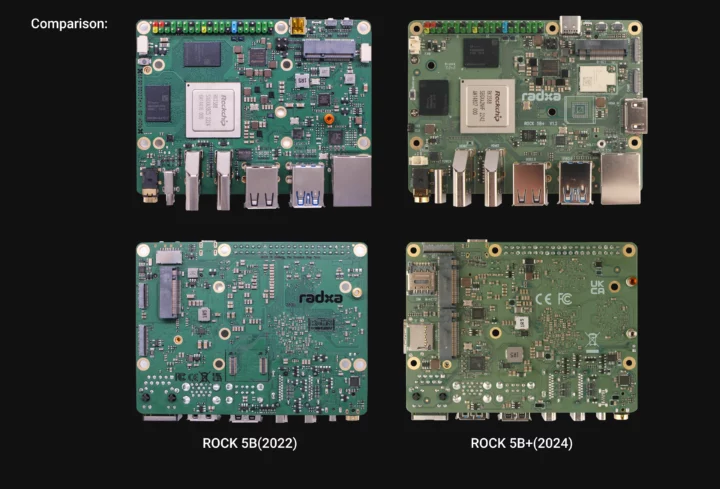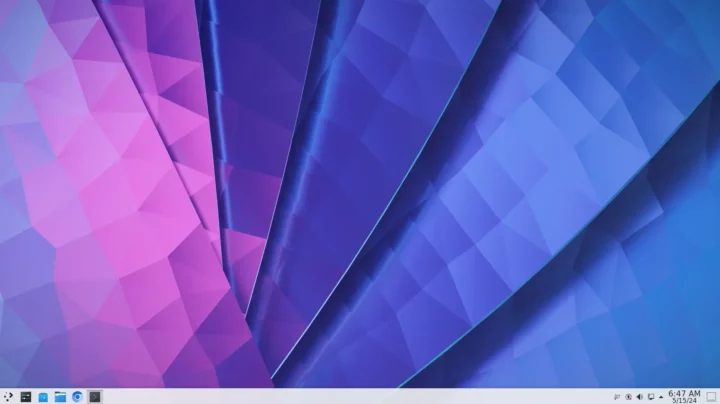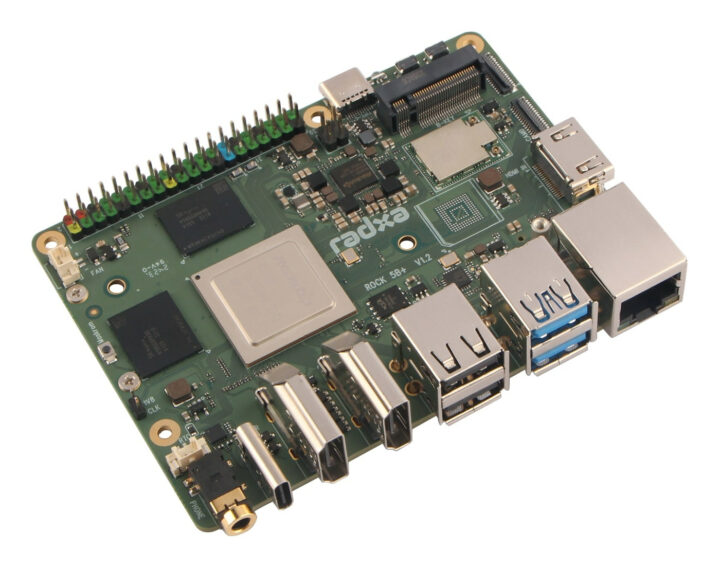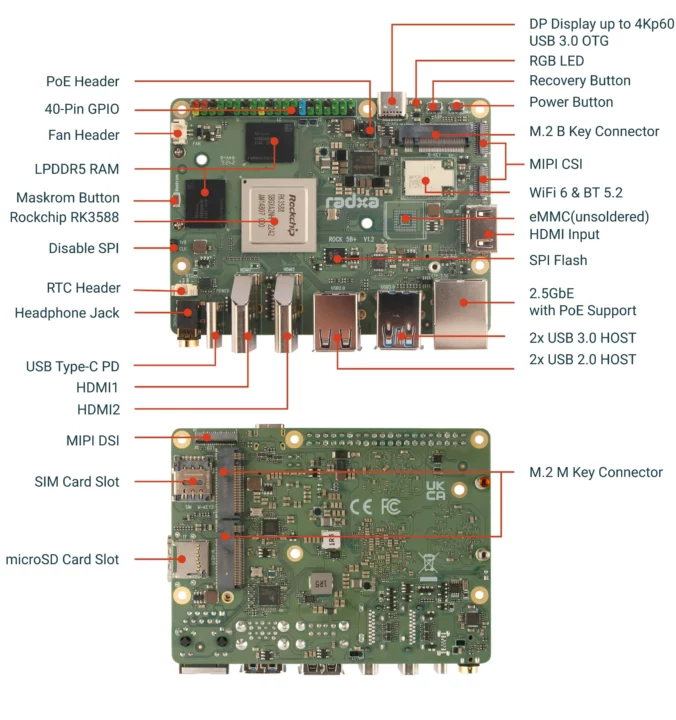The Radxa ROCK 5B+ (“ROCK 5B Plus”) is an upgrade to the Rockchip RK3588-powered ROCK 5B Pico-ITX SBC with the same form factor but various changes including a switch from LPDDR4x to LPDDR5, optional built-in eMMC flash, and an onboard WiFi 6 and Bluetooth 5.2 module instead of one connected through an M.2 Key-E connector.
Other changes include replacing the M.2 Key-M PCIe Gen 3 x4 socket with two M.2 Key-M PCIe Gen3 x2 sockets, adding a SIM card slot and M.2 Key-B socket for 4G LTE or 5G cellular connectivity, adding an extra USB-C port for power only (was multiplexed with USB-C Display Port connected in ROCK 5B), and the HDMI input relies on a full-size HDMI port instead of a micro HDMI port. Other small changes can be found in the specifications below with differences highlighted in bold and strikethrough.
Radxa ROCK 5B+ specifications:
- SoC – Rockchip RK3588
- CPU – Octa-core processor with four Cortex-A76 cores @ 2.4 GHz, four Cortex-A55 cores @ 1.8 GHz
- GPU – Arm Mali G610MC4 GPU
- VPU
- 8Kp60 10-bit H.265 / VP9 / AVS2 decoder, 8Kp30 H.264 decoder
- 8Kp30 H.265 / H.264 encoder
- AI accelerator – 6 TOPS NPU
- System Memory – 4GB, 8GB, 16GB. 24GB, or 32GB LPDDR5
LPDDR4x - Storage
- 2x M.2 Key-M 2280 sockets for NVMe SSD (PCIe 3.0 x2)
- MicroSD card slot
- eMMC flash
socket(unpopulated on currently sold ROCK 5B+ variants)
- SPI flash
- Video Output
- 2x HDMI 2.1 up to 8Kp60
- 1x USB-C via DisplayPort alt. mode up to 8Kp30
- MIPI DSI connector up to 1080p60
- Four independent displays supported
- Video Input
- 1x
microHDMI input up to 4Kp60 - 2x MIPI CSI connectors (updated to 2x 4-lane or 4x 2-lane MIPI CSI for connecting up to 4x cameras)
- 1x
- Networking
- 2.5 Gbps Ethernet RJ45 port with PoE support
- Built-in WiFi 6 and Bluetooth 5.2 module (RTL8852BE) with two antenna connectors
Support for WiFi 6E and Bluetooth 5.2 M.2 module- Support for 4G LTE and 5G module via M.2 Key-B socket and SIM card slot
- USB
- 2x USB 3.1 Gen 1 Type-A ports
- 1x USB 3.1 Gen 1 Type-C port with DisplayPort Alt. mode (USB PD not supported)
- 2x USB 2.0 ports
- Expansion
- 40-pin color-coded GPIO header
- 2x M.2 PCIe Key-M socket for SSD or AI accelerators
- 1x M.2 Key-B socket and SIM card slot for cellular modules
- Misc
- Power, MaskROM, and Recovery buttons
- RGB LED
- RTC battery header
- Fan header
- Disable SPI jumper
- Power Supply
- USB-C PD connector (power only)
- Optional PoE support
- Dimensions – 100 x 72mm (Pico-ITX form factor)
The layout has changed a bit but not dramatically, so some ROCK 5B enclosures might still be compatible possibly with some small modifications (e.g. for the HDMI input port). The Radxa ROCK 5B used to have four holes for the heatsink, but the number has been reduced to two on the ROCK 5B+ allowing extra space for the new features. The ROCK 5B+ is an upgrade in most aspects, except for the PCIe Gen 3 x4 speed previously available for the NVMe SSD which is now cut in half. Most people seem happy getting an SSD with a PCIe Gen2 or Gen3 x1 on Raspberry Pi 5, so Radxa may have figured out that having two M.2 Key-M sockets would benefit users for SSDs and/or AI accelerators even with the lower speed.
LPDDR5 offers higher bandwidth than LPDDR4x, but in practice, LPDDR5 latency is higher than LPDDR4/4x (specification/protocol issue), and the LPDDR5 clock is also set lower in Rockchip’s rkbin for improved stability, so higher performance is not guaranteed depending on the workload. At least that’s the case in ROCK 5 ITX mini-ITX motherboard, and some users also reported LPDDR5 frequency dropping sharply under load due to an aggressive DMC (Dynamic Memory Controller) configuration that works a bit like DVFS for the CPU.

The Radxa ROCK 5B and Radxa ROCK 5B+ share the same wiki, but each board has its own Debian-based Radxa OS image with features such as auto-login, backup OS, headless mode, online updates, Rsetup system configuration tool, and more. Other supported operating systems include Android 12, ChromiumOS-based FydeOS with Android app compatibility, Windows On R, and Yocto-built custom-embedded Linux images.

Radxa sells the ROCK 5B+ single board computer on AliExpress for $119.40 (16GB RAM) or $159.16 (24GB RAM). The 4GB RAM variant is supposed to start at $70, and the 8GB model at $90, but neither model is currently unavailable on AliExpress, Arace Tech, and AllNetChina websites. Models with eMMC flash are planned for later. Additional information may be found on the product page.

Jean-Luc started CNX Software in 2010 as a part-time endeavor, before quitting his job as a software engineering manager, and starting to write daily news, and reviews full time later in 2011.
Support CNX Software! Donate via cryptocurrencies, become a Patron on Patreon, or purchase goods on Amazon or Aliexpress. We also use affiliate links in articles to earn commissions if you make a purchase after clicking on those links.







Honestly I’m seeing the switch from eMMC socket to on-board as a regression, not as an upgrade as they present it on the site, since it forces you to choose your right storage size when you order the board (if available at all), and forces the vendor to have many combinations in stock. If I had had a socket eMMC on the ROCK 5 ITX, I wouldn’t have needed to go trough the hassle of trying to adapt an SSD to run on the key A slot, I would just have ordered a larger one.
Regarding the DDR5 speed regression, we can only hope that Rockchip will finally address their “stability issues” and figure new reliable settings to run at higher speeds than 2400MHz that are sufficient to recover the performance loss compared to LPDDR4X, otherwise it will be a sad news for vendors like Radxa who tried hard to bring the best technology to their products and end up with lower performance. However it still allows to reach 32 GB, which is not available with LPDDR4X so that’s still not a wasted effort.
And I do really like the dual-M2 setup. There’s no significant use of more than Gen 3 x2 for NVME storage, most devices not being able to reach speeds far above 2GB/s. However many users who want to build small servers are interested in either having an OS storage and a data storage, or to use a redundant setup (RAID1) just because they don’t trust SSDs reliability for long-term data storage (I’m one of those).
I really hope these boards will soon be able to switch to mainline kernel with full support so that we can abandon the rockchip BSP and enter a normal kernel maintenance cycle.
I do appreciate how Radxa designs their boards: first they propose something, then they listen to feedback and try to improve the design to try to address most of the expressed concerns. It’s quite an open way of making products, with a high chance of increasing sales due to sticking close to what users really want.
Orange pi 5 plus has a configuration with 32Gb LPDDR4x
I think the eMMC flash is better for business customers who may integrate the ROCK 5B+ into a product. The last time I tested a board with an eMMC flash module it could come off relatively easily. You wouldn’t want the eMMC flash module to come off during transportation or operation (in a location with vibrations).
Yeah that’s a very good point. While some older eMMC sockets from Odroid or NanoPI had no risk of getting pulled by accident, they were likely limited in frequency. And I can definitely imagine how the tiny modern connectors are ultra-sensitive to vibrations.
Rxda I need a board which is a clone of RPI 5 but with option to use NVME of 2280.
Make it cheaper than RPI5 with 8/16/32 GB RAM options.
I’m fine with giving up on the GPIO and WIFI if it helps.
The original is always better because it will work even 5 years later with new Linux distro.
That would be physically impossible, as the RPi form factor can’t fit a 2280 NVMe drive.
Also, the RPi form factor is crap. Pico-ITX is far superior, as it was designed for commercial use, not for toys.
The OPi 5 Max is around 3mm longer than the RPi and supports 2280 NVME, although I’m not sure why people want to stick to this form factor.
I also like pico-itx for reasons.
Rpi5 was software ready on release day and this is bulletproof.
SSD hats are dirty cheap so I cannot see any problem there.
Also there is no problem to buy Raspberry, keep it for year or so and sell it for nearly for same price.
You cannot do same with Rockchip crap. I have seen sellers desperately selling their Rockchip boards for more then hundred of pounds but there was not interest because you cannot justify the money difference. Also when people get upset because this or that doesn’t work and there is no support or solution they will not forget and developers from far east doesn’t understand this. They do not understand nobody is interested in toys and keep waiting ages until software side is mature and this is not reflected in product price.
This is totally true. RPis used to be much more limited in the past (e.g. lack of crypto and connectivity) but this has been addressed with RPi5. The performance is not topmost but those who want pure CPU perf will not buy an A76 anyway and will rather turn to an x86. While rockchip did a good product with 3588 (quite nice I/O bandwidth), it’s a shame that after all these years they have not fixed their software upstreaming process. To me it means that they’re selling them mostly to garbage vendors who have no problem with a completely bogus BSP that corrupts data, and they don’t care about the rare SBC vendors.
I don’t see where I mentioned anything about the processor, my issue was form factors and you brought up something entirely different.
The m.2 b key is the most interesting feature for me, this will make for an amazing 5G/LTE gateway. A gateway doesn’t need more than one LAN port.
I just hope this port supports both USB and PCIe, not only USB like 99% of all the devices with b key m.2, I should know Wednesday when mine arrives and I begin the laboris task bringing up OpenWrt on such an unsupported device.
@Willy I enjoyed reading your blog posts about the 5B and 5 iTX. I also see the lack of removable eMMC as a step backwards, I guess theoretically someone could create a PCB with BGA on one side and an eMMC connector on the other perhaps.
Your eMMC idea is excellent, you should propose it to Tom! Without changing the PCB routing, they could offer the board with:
Then propose the eMMC modules separately. Those in industrial use cases would buy the soldered version while individuals would likely just buy the adapter version and possibly buy an eMMC module later. They could have done this for the Rock5 ITX as well, it would have been great!
I don’t really know Tom other than by reputation and a little back and forth in email, this is my first Radxa device although I have at least 20 other SBC.
Perhaps he will see these comments, I’ve seen his comments in previous Radxa posts here.
I noticed earlier today the Orange Pi 5 Max has eMMC connectors and BGA pads, perhaps they are moving towards offering both it seems.
http://www.orangepi.org/img/pi5-max/max-22.png
You can probably post your suggestion in the Radxa forum about the 5B/5B+.
> I just hope this port supports both USB and PCIe, not only USB like 99% of all the devices with b key m.2
While Radxa seems not to be able to provide this info anywhere easily accessible at least the product brief deeply hidden somewhere and linked to from nowhere talks about USB only, see section 7.9: https://dl.radxa.com/rock5/5b+/docs/radxa_rock5bp_product_brief_Revision_1.0.pdf
I read that previously Thomas (thanks) and hope the document simply doesn’t mention PCIe being available as well.
It certainly opens up the possibility to use more devices as there are some 5G modems which are PCIe only.
> there are some 5G modems which are PCIe only.
Most probably for this reason it’s written ‘M.2 B Key connector providing USB signals and supporting 4G modules’.
But hey, product launch day in the past, still no schematics released, ‘happy’ customers (having to buy HW to analyze capabilities on their own).
I’ve been looking for the docs folder to populate but nothing other than the PDF you linked and the board step file so far.
If a manufacturer doesn’t mention a selling point like that, draw your own conclusions.
Mine: no support for PCIe.
Most gateway manufacturers don’t mention it either.
I hold out hope but have tempered expectations.
I’ve just noticed the GPIO header pinout has changed too albeit only two pins (29 and 31)